BMP3004 World of Work: Employee Motivation Factors and Strategies
VerifiedAdded on 2023/06/18
|8
|2172
|71
Report
AI Summary
This report delves into the multifaceted concept of motivation in the workplace, examining the various factors that drive employees, the positive and negative outcomes they experience as a result of their job roles, and effective strategies to cope with negative factors. It begins by defining motivation, differentiating between intrinsic and extrinsic forms, and referencing Maslow's hierarchy of needs to illustrate the different levels of human wants that influence motivation. The report identifies salary, promotion, and work environment as key factors that motivate employees, further elaborating on the significance of rewards and recognition, company culture, and professional development opportunities. It also acknowledges the negative impact of workplace conflicts, poor management, and unfair policies on employee motivation. To address these negative factors, the report suggests strategies such as providing opportunities for expressing opinions, fostering trust and respect, and offering appropriate recognition. The conclusion emphasizes the importance of employee motivation for greater satisfaction and improved performance, highlighting its role in coping with negative experiences in the job role. This document is available on Desklib, a platform offering a wealth of study resources for students.
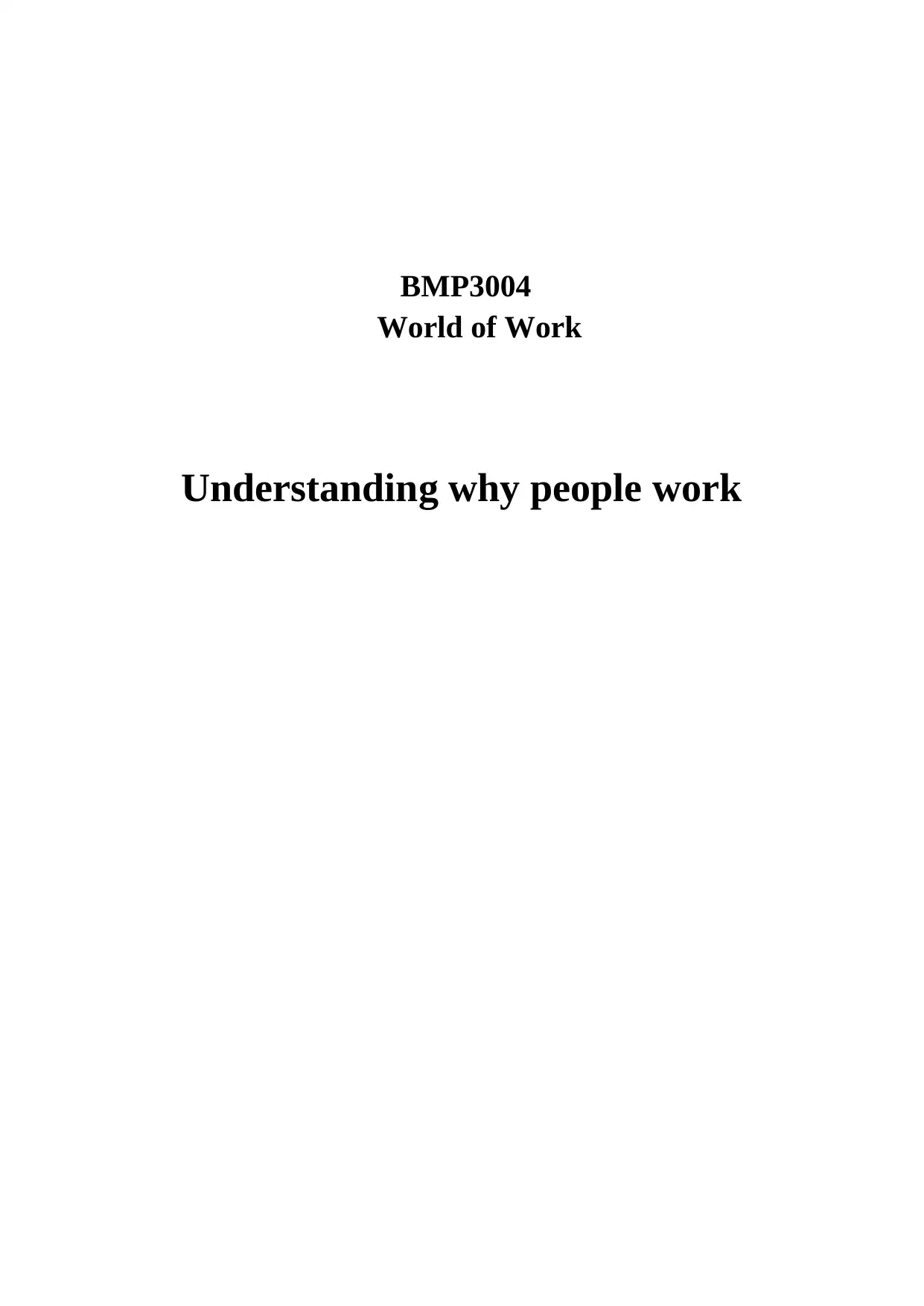
BMP3004
World of Work
Understanding why people work
World of Work
Understanding why people work
Paraphrase This Document
Need a fresh take? Get an instant paraphrase of this document with our AI Paraphraser
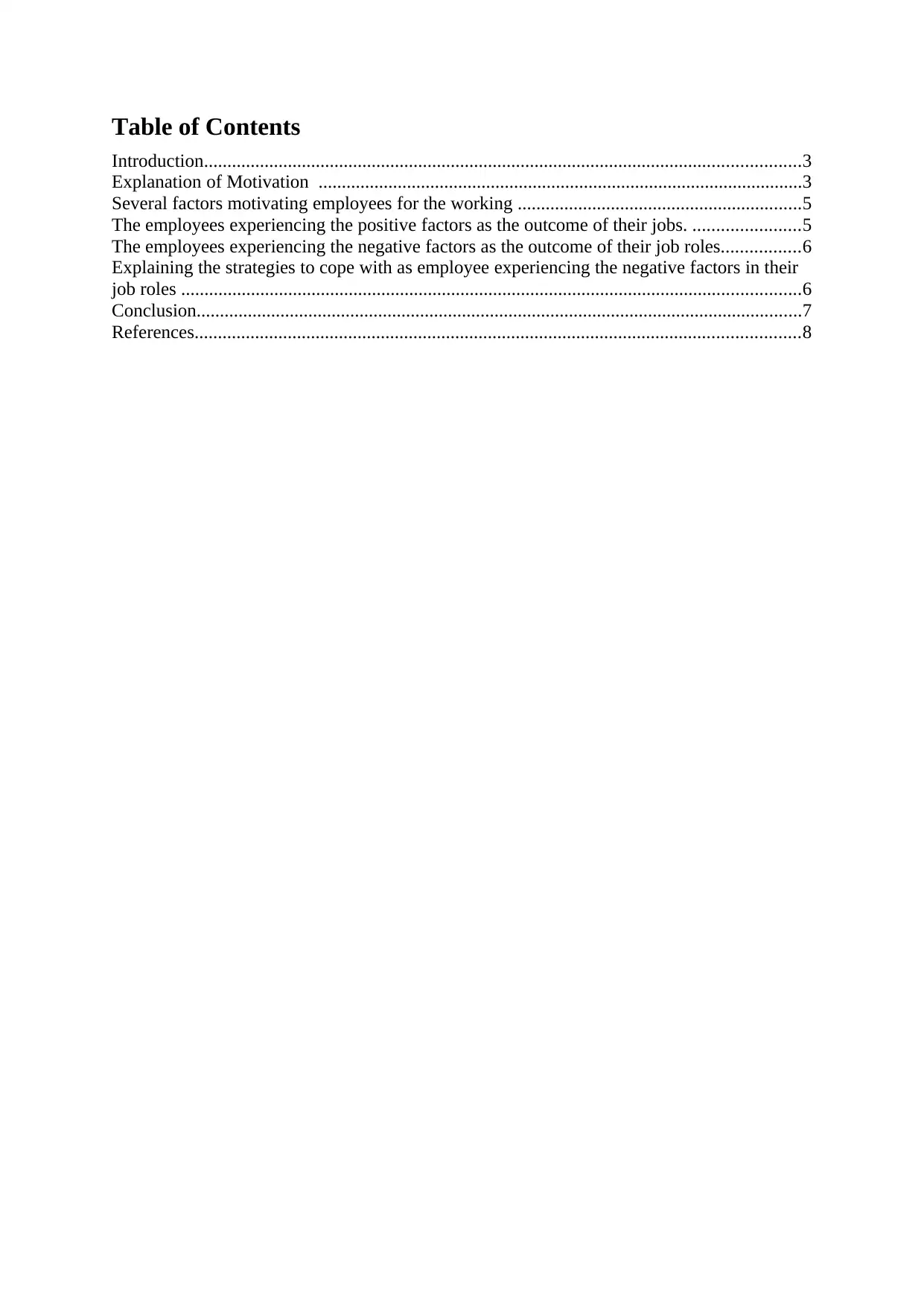
Table of Contents
Introduction................................................................................................................................3
Explanation of Motivation ........................................................................................................3
Several factors motivating employees for the working .............................................................5
The employees experiencing the positive factors as the outcome of their jobs. .......................5
The employees experiencing the negative factors as the outcome of their job roles.................6
Explaining the strategies to cope with as employee experiencing the negative factors in their
job roles .....................................................................................................................................6
Conclusion..................................................................................................................................7
References..................................................................................................................................8
Introduction................................................................................................................................3
Explanation of Motivation ........................................................................................................3
Several factors motivating employees for the working .............................................................5
The employees experiencing the positive factors as the outcome of their jobs. .......................5
The employees experiencing the negative factors as the outcome of their job roles.................6
Explaining the strategies to cope with as employee experiencing the negative factors in their
job roles .....................................................................................................................................6
Conclusion..................................................................................................................................7
References..................................................................................................................................8
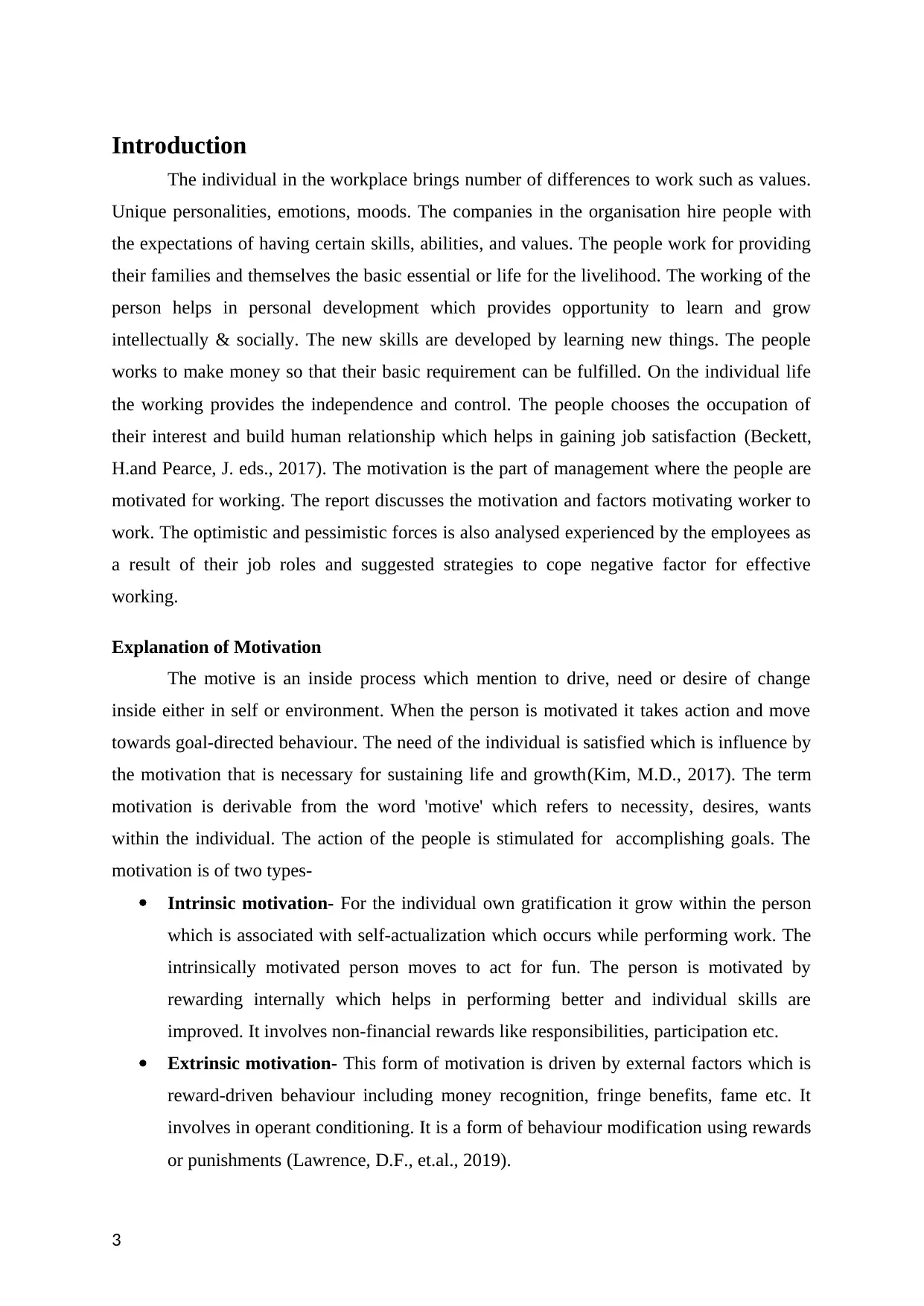
Introduction
The individual in the workplace brings number of differences to work such as values.
Unique personalities, emotions, moods. The companies in the organisation hire people with
the expectations of having certain skills, abilities, and values. The people work for providing
their families and themselves the basic essential or life for the livelihood. The working of the
person helps in personal development which provides opportunity to learn and grow
intellectually & socially. The new skills are developed by learning new things. The people
works to make money so that their basic requirement can be fulfilled. On the individual life
the working provides the independence and control. The people chooses the occupation of
their interest and build human relationship which helps in gaining job satisfaction (Beckett,
H.and Pearce, J. eds., 2017). The motivation is the part of management where the people are
motivated for working. The report discusses the motivation and factors motivating worker to
work. The optimistic and pessimistic forces is also analysed experienced by the employees as
a result of their job roles and suggested strategies to cope negative factor for effective
working.
Explanation of Motivation
The motive is an inside process which mention to drive, need or desire of change
inside either in self or environment. When the person is motivated it takes action and move
towards goal-directed behaviour. The need of the individual is satisfied which is influence by
the motivation that is necessary for sustaining life and growth(Kim, M.D., 2017). The term
motivation is derivable from the word 'motive' which refers to necessity, desires, wants
within the individual. The action of the people is stimulated for accomplishing goals. The
motivation is of two types-
Intrinsic motivation- For the individual own gratification it grow within the person
which is associated with self-actualization which occurs while performing work. The
intrinsically motivated person moves to act for fun. The person is motivated by
rewarding internally which helps in performing better and individual skills are
improved. It involves non-financial rewards like responsibilities, participation etc.
Extrinsic motivation- This form of motivation is driven by external factors which is
reward-driven behaviour including money recognition, fringe benefits, fame etc. It
involves in operant conditioning. It is a form of behaviour modification using rewards
or punishments (Lawrence, D.F., et.al., 2019).
3
The individual in the workplace brings number of differences to work such as values.
Unique personalities, emotions, moods. The companies in the organisation hire people with
the expectations of having certain skills, abilities, and values. The people work for providing
their families and themselves the basic essential or life for the livelihood. The working of the
person helps in personal development which provides opportunity to learn and grow
intellectually & socially. The new skills are developed by learning new things. The people
works to make money so that their basic requirement can be fulfilled. On the individual life
the working provides the independence and control. The people chooses the occupation of
their interest and build human relationship which helps in gaining job satisfaction (Beckett,
H.and Pearce, J. eds., 2017). The motivation is the part of management where the people are
motivated for working. The report discusses the motivation and factors motivating worker to
work. The optimistic and pessimistic forces is also analysed experienced by the employees as
a result of their job roles and suggested strategies to cope negative factor for effective
working.
Explanation of Motivation
The motive is an inside process which mention to drive, need or desire of change
inside either in self or environment. When the person is motivated it takes action and move
towards goal-directed behaviour. The need of the individual is satisfied which is influence by
the motivation that is necessary for sustaining life and growth(Kim, M.D., 2017). The term
motivation is derivable from the word 'motive' which refers to necessity, desires, wants
within the individual. The action of the people is stimulated for accomplishing goals. The
motivation is of two types-
Intrinsic motivation- For the individual own gratification it grow within the person
which is associated with self-actualization which occurs while performing work. The
intrinsically motivated person moves to act for fun. The person is motivated by
rewarding internally which helps in performing better and individual skills are
improved. It involves non-financial rewards like responsibilities, participation etc.
Extrinsic motivation- This form of motivation is driven by external factors which is
reward-driven behaviour including money recognition, fringe benefits, fame etc. It
involves in operant conditioning. It is a form of behaviour modification using rewards
or punishments (Lawrence, D.F., et.al., 2019).
3
⊘ This is a preview!⊘
Do you want full access?
Subscribe today to unlock all pages.

Trusted by 1+ million students worldwide
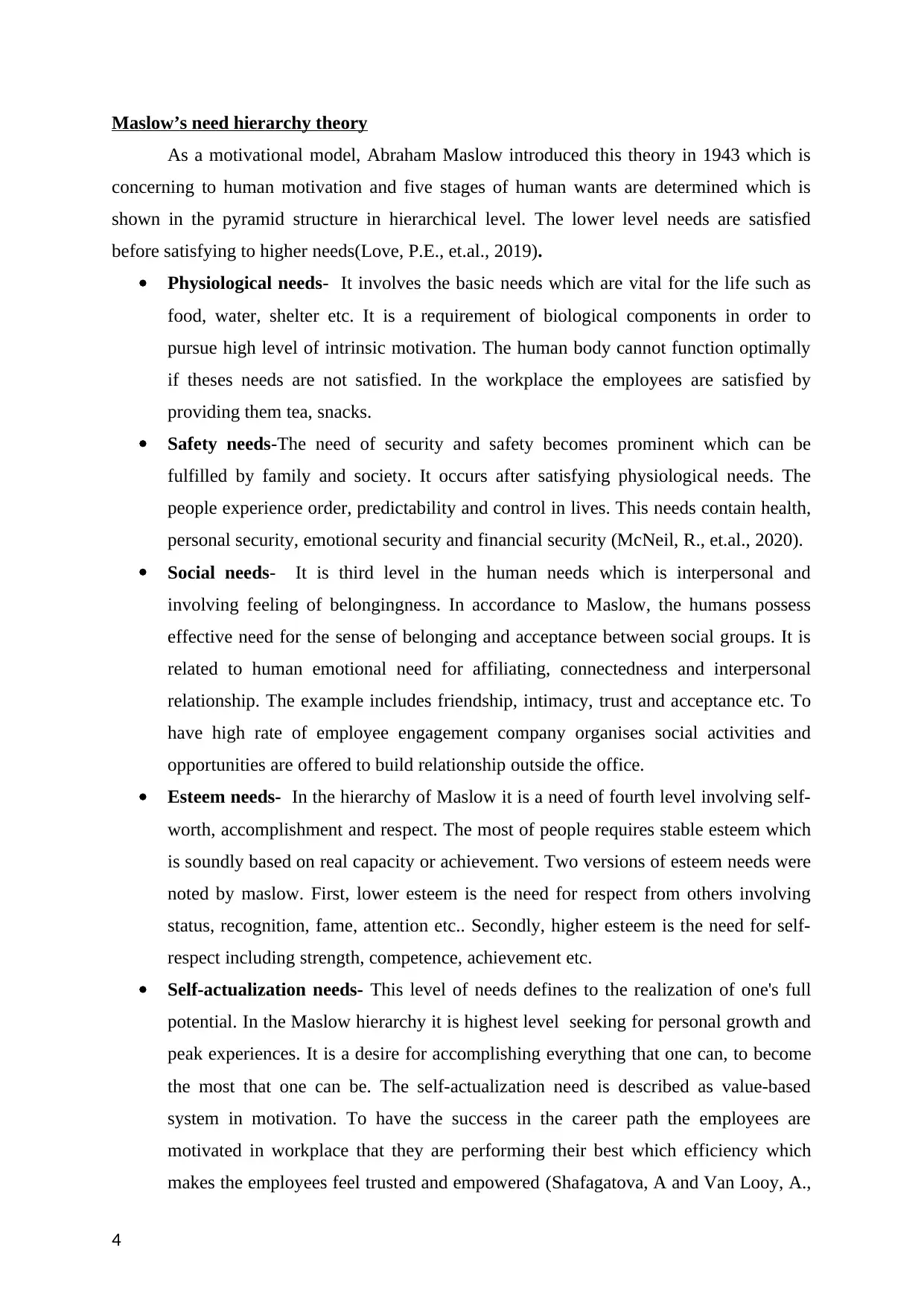
Maslow’s need hierarchy theory
As a motivational model, Abraham Maslow introduced this theory in 1943 which is
concerning to human motivation and five stages of human wants are determined which is
shown in the pyramid structure in hierarchical level. The lower level needs are satisfied
before satisfying to higher needs(Love, P.E., et.al., 2019).
Physiological needs- It involves the basic needs which are vital for the life such as
food, water, shelter etc. It is a requirement of biological components in order to
pursue high level of intrinsic motivation. The human body cannot function optimally
if theses needs are not satisfied. In the workplace the employees are satisfied by
providing them tea, snacks.
Safety needs-The need of security and safety becomes prominent which can be
fulfilled by family and society. It occurs after satisfying physiological needs. The
people experience order, predictability and control in lives. This needs contain health,
personal security, emotional security and financial security (McNeil, R., et.al., 2020).
Social needs- It is third level in the human needs which is interpersonal and
involving feeling of belongingness. In accordance to Maslow, the humans possess
effective need for the sense of belonging and acceptance between social groups. It is
related to human emotional need for affiliating, connectedness and interpersonal
relationship. The example includes friendship, intimacy, trust and acceptance etc. To
have high rate of employee engagement company organises social activities and
opportunities are offered to build relationship outside the office.
Esteem needs- In the hierarchy of Maslow it is a need of fourth level involving self-
worth, accomplishment and respect. The most of people requires stable esteem which
is soundly based on real capacity or achievement. Two versions of esteem needs were
noted by maslow. First, lower esteem is the need for respect from others involving
status, recognition, fame, attention etc.. Secondly, higher esteem is the need for self-
respect including strength, competence, achievement etc.
Self-actualization needs- This level of needs defines to the realization of one's full
potential. In the Maslow hierarchy it is highest level seeking for personal growth and
peak experiences. It is a desire for accomplishing everything that one can, to become
the most that one can be. The self-actualization need is described as value-based
system in motivation. To have the success in the career path the employees are
motivated in workplace that they are performing their best which efficiency which
makes the employees feel trusted and empowered (Shafagatova, A and Van Looy, A.,
4
As a motivational model, Abraham Maslow introduced this theory in 1943 which is
concerning to human motivation and five stages of human wants are determined which is
shown in the pyramid structure in hierarchical level. The lower level needs are satisfied
before satisfying to higher needs(Love, P.E., et.al., 2019).
Physiological needs- It involves the basic needs which are vital for the life such as
food, water, shelter etc. It is a requirement of biological components in order to
pursue high level of intrinsic motivation. The human body cannot function optimally
if theses needs are not satisfied. In the workplace the employees are satisfied by
providing them tea, snacks.
Safety needs-The need of security and safety becomes prominent which can be
fulfilled by family and society. It occurs after satisfying physiological needs. The
people experience order, predictability and control in lives. This needs contain health,
personal security, emotional security and financial security (McNeil, R., et.al., 2020).
Social needs- It is third level in the human needs which is interpersonal and
involving feeling of belongingness. In accordance to Maslow, the humans possess
effective need for the sense of belonging and acceptance between social groups. It is
related to human emotional need for affiliating, connectedness and interpersonal
relationship. The example includes friendship, intimacy, trust and acceptance etc. To
have high rate of employee engagement company organises social activities and
opportunities are offered to build relationship outside the office.
Esteem needs- In the hierarchy of Maslow it is a need of fourth level involving self-
worth, accomplishment and respect. The most of people requires stable esteem which
is soundly based on real capacity or achievement. Two versions of esteem needs were
noted by maslow. First, lower esteem is the need for respect from others involving
status, recognition, fame, attention etc.. Secondly, higher esteem is the need for self-
respect including strength, competence, achievement etc.
Self-actualization needs- This level of needs defines to the realization of one's full
potential. In the Maslow hierarchy it is highest level seeking for personal growth and
peak experiences. It is a desire for accomplishing everything that one can, to become
the most that one can be. The self-actualization need is described as value-based
system in motivation. To have the success in the career path the employees are
motivated in workplace that they are performing their best which efficiency which
makes the employees feel trusted and empowered (Shafagatova, A and Van Looy, A.,
4
Paraphrase This Document
Need a fresh take? Get an instant paraphrase of this document with our AI Paraphraser
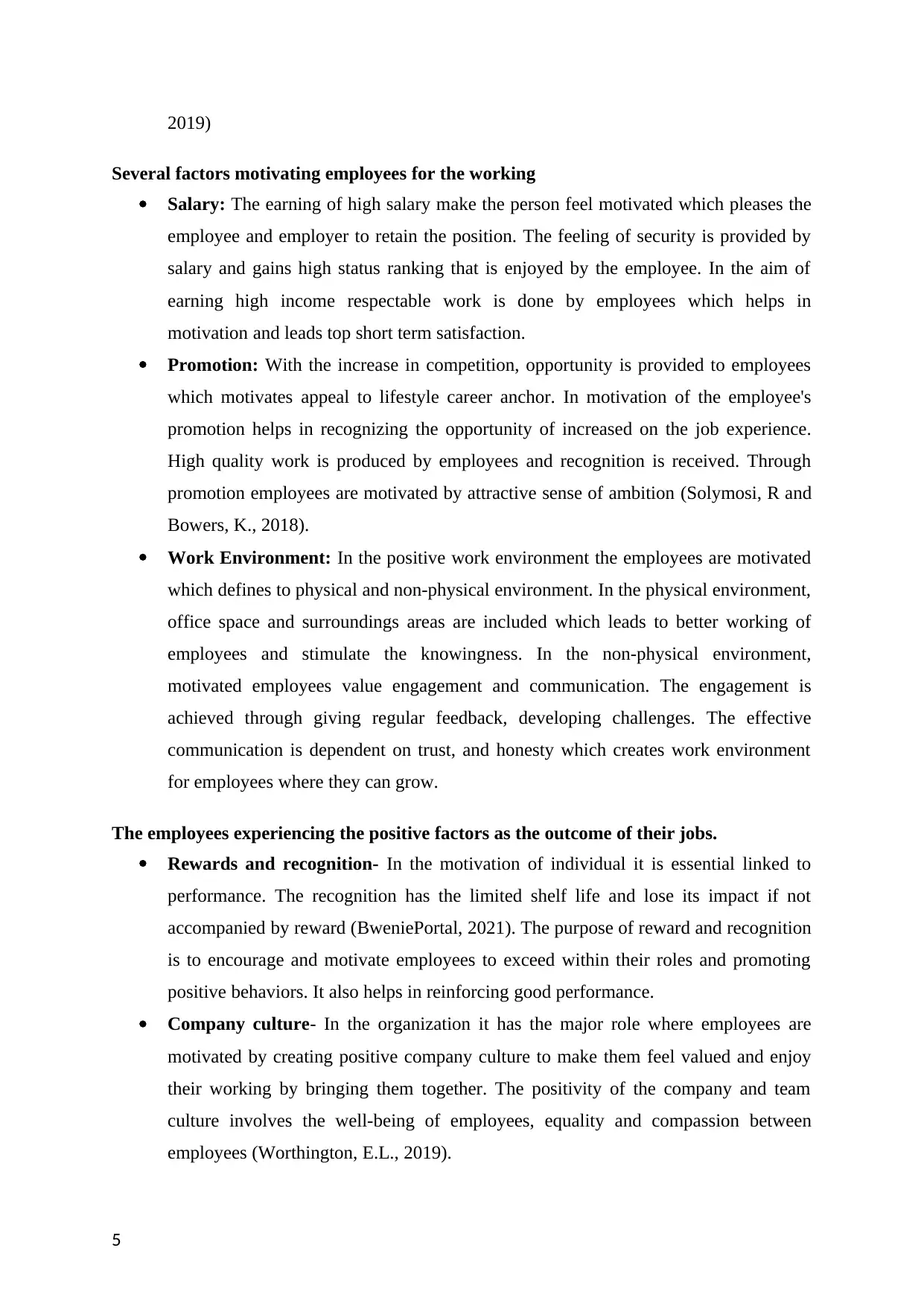
2019)
Several factors motivating employees for the working
Salary: The earning of high salary make the person feel motivated which pleases the
employee and employer to retain the position. The feeling of security is provided by
salary and gains high status ranking that is enjoyed by the employee. In the aim of
earning high income respectable work is done by employees which helps in
motivation and leads top short term satisfaction.
Promotion: With the increase in competition, opportunity is provided to employees
which motivates appeal to lifestyle career anchor. In motivation of the employee's
promotion helps in recognizing the opportunity of increased on the job experience.
High quality work is produced by employees and recognition is received. Through
promotion employees are motivated by attractive sense of ambition (Solymosi, R and
Bowers, K., 2018).
Work Environment: In the positive work environment the employees are motivated
which defines to physical and non-physical environment. In the physical environment,
office space and surroundings areas are included which leads to better working of
employees and stimulate the knowingness. In the non-physical environment,
motivated employees value engagement and communication. The engagement is
achieved through giving regular feedback, developing challenges. The effective
communication is dependent on trust, and honesty which creates work environment
for employees where they can grow.
The employees experiencing the positive factors as the outcome of their jobs.
Rewards and recognition- In the motivation of individual it is essential linked to
performance. The recognition has the limited shelf life and lose its impact if not
accompanied by reward (BweniePortal, 2021). The purpose of reward and recognition
is to encourage and motivate employees to exceed within their roles and promoting
positive behaviors. It also helps in reinforcing good performance.
Company culture- In the organization it has the major role where employees are
motivated by creating positive company culture to make them feel valued and enjoy
their working by bringing them together. The positivity of the company and team
culture involves the well-being of employees, equality and compassion between
employees (Worthington, E.L., 2019).
5
Several factors motivating employees for the working
Salary: The earning of high salary make the person feel motivated which pleases the
employee and employer to retain the position. The feeling of security is provided by
salary and gains high status ranking that is enjoyed by the employee. In the aim of
earning high income respectable work is done by employees which helps in
motivation and leads top short term satisfaction.
Promotion: With the increase in competition, opportunity is provided to employees
which motivates appeal to lifestyle career anchor. In motivation of the employee's
promotion helps in recognizing the opportunity of increased on the job experience.
High quality work is produced by employees and recognition is received. Through
promotion employees are motivated by attractive sense of ambition (Solymosi, R and
Bowers, K., 2018).
Work Environment: In the positive work environment the employees are motivated
which defines to physical and non-physical environment. In the physical environment,
office space and surroundings areas are included which leads to better working of
employees and stimulate the knowingness. In the non-physical environment,
motivated employees value engagement and communication. The engagement is
achieved through giving regular feedback, developing challenges. The effective
communication is dependent on trust, and honesty which creates work environment
for employees where they can grow.
The employees experiencing the positive factors as the outcome of their jobs.
Rewards and recognition- In the motivation of individual it is essential linked to
performance. The recognition has the limited shelf life and lose its impact if not
accompanied by reward (BweniePortal, 2021). The purpose of reward and recognition
is to encourage and motivate employees to exceed within their roles and promoting
positive behaviors. It also helps in reinforcing good performance.
Company culture- In the organization it has the major role where employees are
motivated by creating positive company culture to make them feel valued and enjoy
their working by bringing them together. The positivity of the company and team
culture involves the well-being of employees, equality and compassion between
employees (Worthington, E.L., 2019).
5
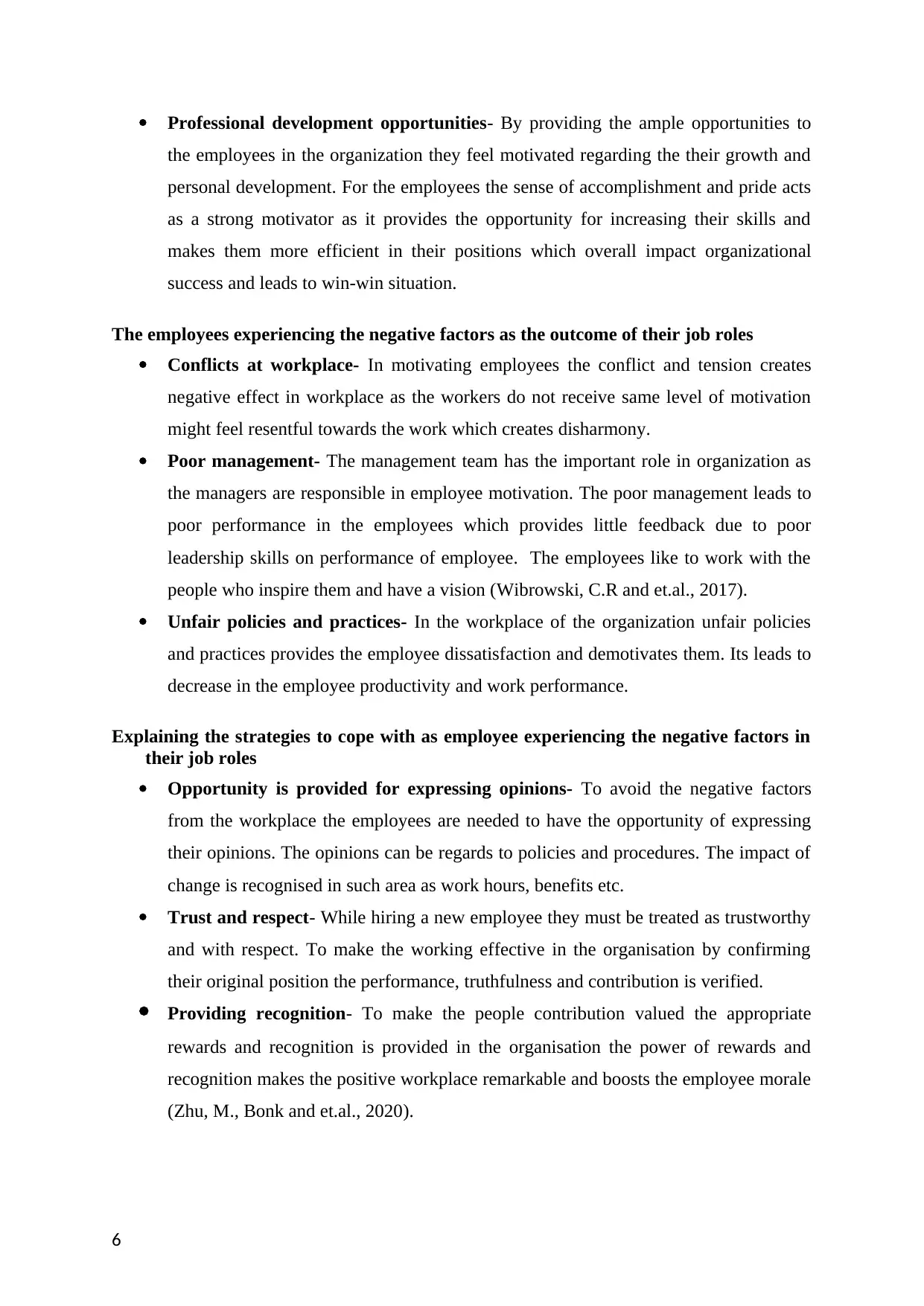
Professional development opportunities- By providing the ample opportunities to
the employees in the organization they feel motivated regarding the their growth and
personal development. For the employees the sense of accomplishment and pride acts
as a strong motivator as it provides the opportunity for increasing their skills and
makes them more efficient in their positions which overall impact organizational
success and leads to win-win situation.
The employees experiencing the negative factors as the outcome of their job roles
Conflicts at workplace- In motivating employees the conflict and tension creates
negative effect in workplace as the workers do not receive same level of motivation
might feel resentful towards the work which creates disharmony.
Poor management- The management team has the important role in organization as
the managers are responsible in employee motivation. The poor management leads to
poor performance in the employees which provides little feedback due to poor
leadership skills on performance of employee. The employees like to work with the
people who inspire them and have a vision (Wibrowski, C.R and et.al., 2017).
Unfair policies and practices- In the workplace of the organization unfair policies
and practices provides the employee dissatisfaction and demotivates them. Its leads to
decrease in the employee productivity and work performance.
Explaining the strategies to cope with as employee experiencing the negative factors in
their job roles
Opportunity is provided for expressing opinions- To avoid the negative factors
from the workplace the employees are needed to have the opportunity of expressing
their opinions. The opinions can be regards to policies and procedures. The impact of
change is recognised in such area as work hours, benefits etc.
Trust and respect- While hiring a new employee they must be treated as trustworthy
and with respect. To make the working effective in the organisation by confirming
their original position the performance, truthfulness and contribution is verified.
Providing recognition- To make the people contribution valued the appropriate
rewards and recognition is provided in the organisation the power of rewards and
recognition makes the positive workplace remarkable and boosts the employee morale
(Zhu, M., Bonk and et.al., 2020).
6
the employees in the organization they feel motivated regarding the their growth and
personal development. For the employees the sense of accomplishment and pride acts
as a strong motivator as it provides the opportunity for increasing their skills and
makes them more efficient in their positions which overall impact organizational
success and leads to win-win situation.
The employees experiencing the negative factors as the outcome of their job roles
Conflicts at workplace- In motivating employees the conflict and tension creates
negative effect in workplace as the workers do not receive same level of motivation
might feel resentful towards the work which creates disharmony.
Poor management- The management team has the important role in organization as
the managers are responsible in employee motivation. The poor management leads to
poor performance in the employees which provides little feedback due to poor
leadership skills on performance of employee. The employees like to work with the
people who inspire them and have a vision (Wibrowski, C.R and et.al., 2017).
Unfair policies and practices- In the workplace of the organization unfair policies
and practices provides the employee dissatisfaction and demotivates them. Its leads to
decrease in the employee productivity and work performance.
Explaining the strategies to cope with as employee experiencing the negative factors in
their job roles
Opportunity is provided for expressing opinions- To avoid the negative factors
from the workplace the employees are needed to have the opportunity of expressing
their opinions. The opinions can be regards to policies and procedures. The impact of
change is recognised in such area as work hours, benefits etc.
Trust and respect- While hiring a new employee they must be treated as trustworthy
and with respect. To make the working effective in the organisation by confirming
their original position the performance, truthfulness and contribution is verified.
Providing recognition- To make the people contribution valued the appropriate
rewards and recognition is provided in the organisation the power of rewards and
recognition makes the positive workplace remarkable and boosts the employee morale
(Zhu, M., Bonk and et.al., 2020).
6
⊘ This is a preview!⊘
Do you want full access?
Subscribe today to unlock all pages.

Trusted by 1+ million students worldwide
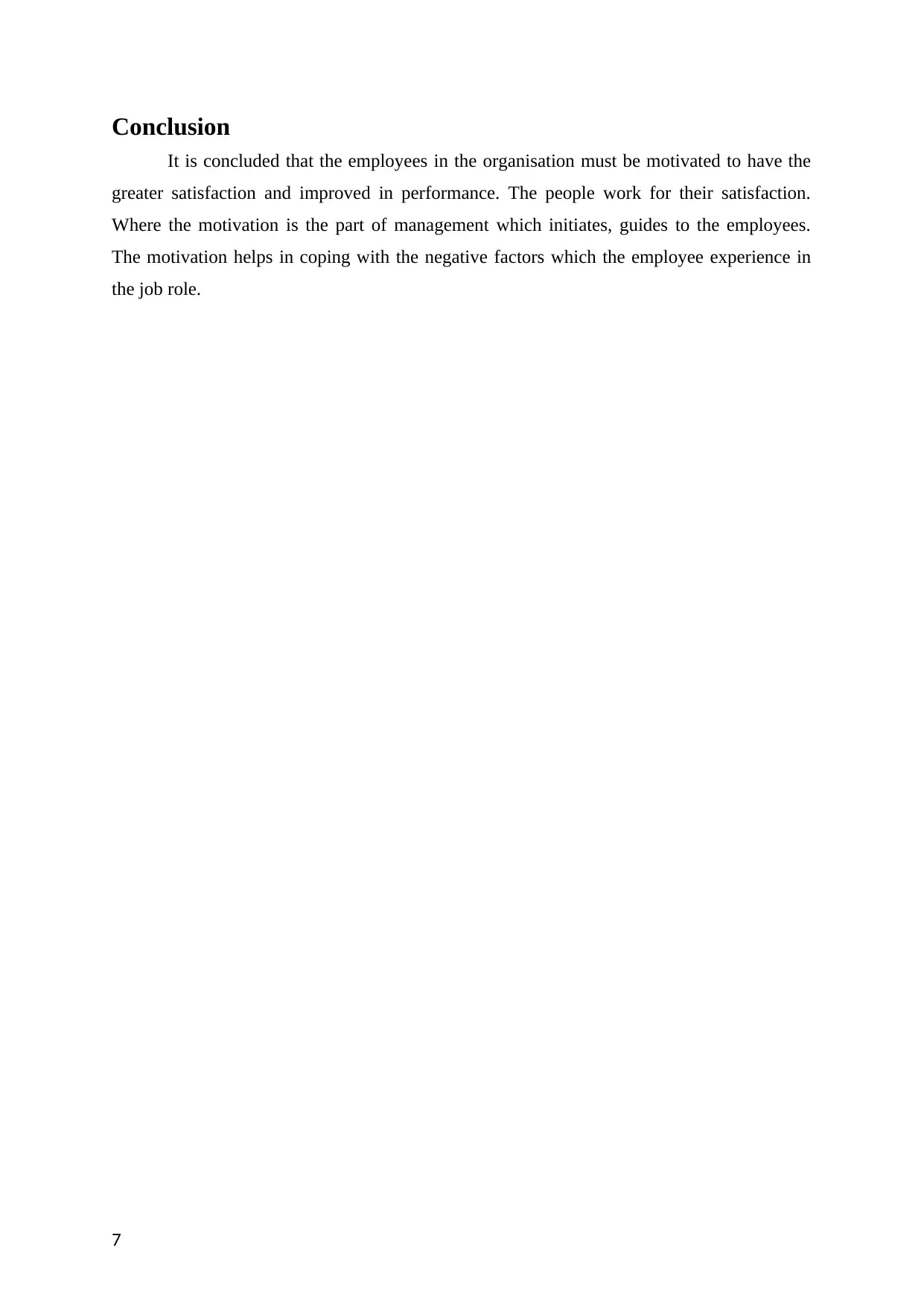
Conclusion
It is concluded that the employees in the organisation must be motivated to have the
greater satisfaction and improved in performance. The people work for their satisfaction.
Where the motivation is the part of management which initiates, guides to the employees.
The motivation helps in coping with the negative factors which the employee experience in
the job role.
7
It is concluded that the employees in the organisation must be motivated to have the
greater satisfaction and improved in performance. The people work for their satisfaction.
Where the motivation is the part of management which initiates, guides to the employees.
The motivation helps in coping with the negative factors which the employee experience in
the job role.
7
Paraphrase This Document
Need a fresh take? Get an instant paraphrase of this document with our AI Paraphraser
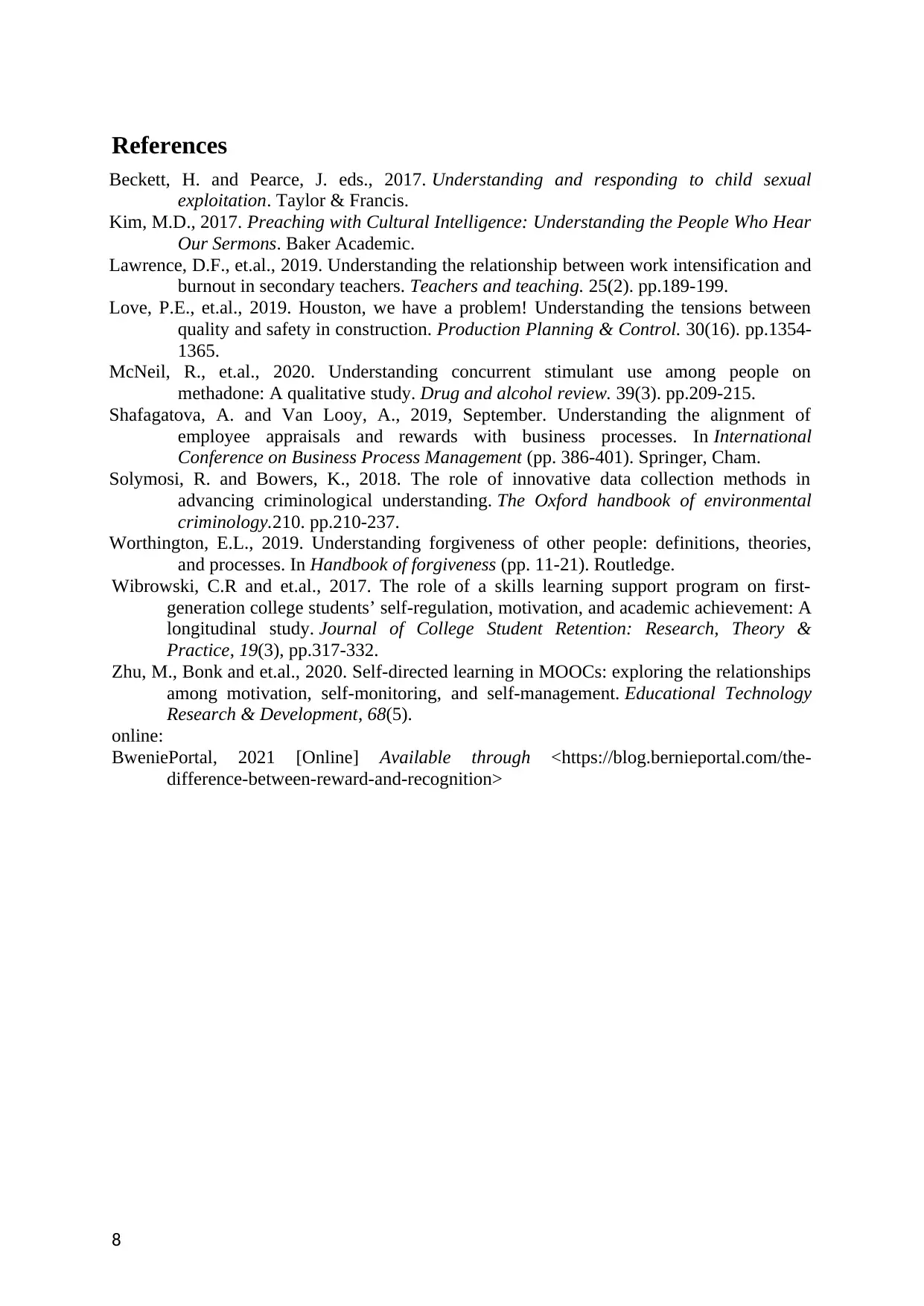
References
Beckett, H. and Pearce, J. eds., 2017. Understanding and responding to child sexual
exploitation. Taylor & Francis.
Kim, M.D., 2017. Preaching with Cultural Intelligence: Understanding the People Who Hear
Our Sermons. Baker Academic.
Lawrence, D.F., et.al., 2019. Understanding the relationship between work intensification and
burnout in secondary teachers. Teachers and teaching. 25(2). pp.189-199.
Love, P.E., et.al., 2019. Houston, we have a problem! Understanding the tensions between
quality and safety in construction. Production Planning & Control. 30(16). pp.1354-
1365.
McNeil, R., et.al., 2020. Understanding concurrent stimulant use among people on
methadone: A qualitative study. Drug and alcohol review. 39(3). pp.209-215.
Shafagatova, A. and Van Looy, A., 2019, September. Understanding the alignment of
employee appraisals and rewards with business processes. In International
Conference on Business Process Management (pp. 386-401). Springer, Cham.
Solymosi, R. and Bowers, K., 2018. The role of innovative data collection methods in
advancing criminological understanding. The Oxford handbook of environmental
criminology.210. pp.210-237.
Worthington, E.L., 2019. Understanding forgiveness of other people: definitions, theories,
and processes. In Handbook of forgiveness (pp. 11-21). Routledge.
Wibrowski, C.R and et.al., 2017. The role of a skills learning support program on first-
generation college students’ self-regulation, motivation, and academic achievement: A
longitudinal study. Journal of College Student Retention: Research, Theory &
Practice, 19(3), pp.317-332.
Zhu, M., Bonk and et.al., 2020. Self-directed learning in MOOCs: exploring the relationships
among motivation, self-monitoring, and self-management. Educational Technology
Research & Development, 68(5).
online:
BweniePortal, 2021 [Online] Available through <https://blog.bernieportal.com/the-
difference-between-reward-and-recognition>
8
Beckett, H. and Pearce, J. eds., 2017. Understanding and responding to child sexual
exploitation. Taylor & Francis.
Kim, M.D., 2017. Preaching with Cultural Intelligence: Understanding the People Who Hear
Our Sermons. Baker Academic.
Lawrence, D.F., et.al., 2019. Understanding the relationship between work intensification and
burnout in secondary teachers. Teachers and teaching. 25(2). pp.189-199.
Love, P.E., et.al., 2019. Houston, we have a problem! Understanding the tensions between
quality and safety in construction. Production Planning & Control. 30(16). pp.1354-
1365.
McNeil, R., et.al., 2020. Understanding concurrent stimulant use among people on
methadone: A qualitative study. Drug and alcohol review. 39(3). pp.209-215.
Shafagatova, A. and Van Looy, A., 2019, September. Understanding the alignment of
employee appraisals and rewards with business processes. In International
Conference on Business Process Management (pp. 386-401). Springer, Cham.
Solymosi, R. and Bowers, K., 2018. The role of innovative data collection methods in
advancing criminological understanding. The Oxford handbook of environmental
criminology.210. pp.210-237.
Worthington, E.L., 2019. Understanding forgiveness of other people: definitions, theories,
and processes. In Handbook of forgiveness (pp. 11-21). Routledge.
Wibrowski, C.R and et.al., 2017. The role of a skills learning support program on first-
generation college students’ self-regulation, motivation, and academic achievement: A
longitudinal study. Journal of College Student Retention: Research, Theory &
Practice, 19(3), pp.317-332.
Zhu, M., Bonk and et.al., 2020. Self-directed learning in MOOCs: exploring the relationships
among motivation, self-monitoring, and self-management. Educational Technology
Research & Development, 68(5).
online:
BweniePortal, 2021 [Online] Available through <https://blog.bernieportal.com/the-
difference-between-reward-and-recognition>
8
1 out of 8
Related Documents
Your All-in-One AI-Powered Toolkit for Academic Success.
+13062052269
info@desklib.com
Available 24*7 on WhatsApp / Email
![[object Object]](/_next/static/media/star-bottom.7253800d.svg)
Unlock your academic potential
Copyright © 2020–2025 A2Z Services. All Rights Reserved. Developed and managed by ZUCOL.

